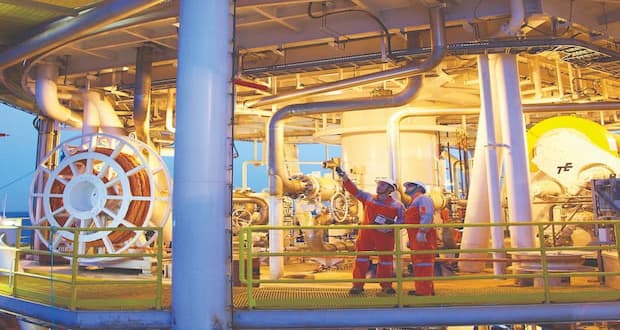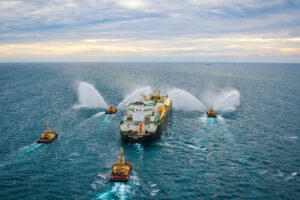Amid regulatory headwinds, Australia seeks policy stability, growth for gas and LNG markets
Industry must continue to position itself as a key player in energy transition, but needs broader support to attract the necessary investment

 By Stephen Whitfield, Senior Editor
By Stephen Whitfield, Senior Editor
Samantha McCulloch is Chief Executive of Australian Energy Producers.
What was the motivation behind your recent name change from APPEA to Australian Energy Producers?
We were the Australian Petroleum Production and Exploration Association for more than 60 years, so it was a name that held us in good stead for decades. But when we looked at the role of our industry today and the role of the industry in our future, it’s actually broader. Of course, we’re exploring for and producing oil and gas, but our industry is key to net-zero technologies, and it’s key to the investment in and deployment of low-emission fuels. We wanted a name that reflects that broader role of the industry.
What do you see as some of the biggest challenges facing the industry in Australia? And what roles can organizations like yours play in helping the industry address those challenges?
It’s a challenging environment as we transform our global energy systems to net zero. Australian Energy Producers has committed to net zero, and we see tremendous opportunities, particularly with the role of natural gas in that transformation, in terms of partnering with renewables to provide power to Australian homes and businesses.
Gas will also play an important role in supporting manufacturing and new industrial opportunities. In Australia, we talk about critical minerals manufacturing opportunities, and gas can be a key partner in that.
Even in a net-zero pathway, we still need oil and gas, so communicating that understanding and translating that into policy settings and support is critical. In Australia, it’s been a very challenging and dynamic policy environment for the past 12 months. We’ve had a range of interventions and policy reforms that have added to the cost and complexity of the operating environment and the investment environment for the industry. That’s had an impact in terms of our reputation.
We’ve had some of our key international investors and customers raising concerns publicly about whether Australia is still a reliable supplier of energy. That’s something that we, as an industry, are very concerned about.
For example, we have seen court decisions overturning approvals for projects that had been approved by the national regulator. We need new regulations to ensure meaningful consultation with Traditional Owners – Aboriginal and Torres Strait Islander people – as well as certainty for business.
We need to ensure we have stability in policy setting and a policy environment that attracts new investment and enables us to continue to be a reliable, secure supplier of energy to the region. That’s really central to the work that we’re doing.
What do you say to those investors who might be a little skeptical of Australia’s energy position?
This all has been the result of months of policy interventions and change, and it has been concerning to the industry and the broader international investment community. There are challenges in Australia’s operating environment, but we think we’ll see greater stability going forward. As an industry, we’re calling on the government for policies that will encourage new domestic supply to ensure our energy security. We have abundant gas resources, but we are in a situation where energy authorities and the energy analysts are forecasting supply shortfalls.
Also, we play such an important role in terms of regional energy security. Our LNG exports underpin many of our strategic relationships in the region and support decarbonization efforts. We want to ensure that we’re able to service the growing demand for LNG and gas in our region.
Can you provide some examples of regulatory changes that have had this negative effect on operating costs in the region? What kind of impact have they had, exactly?
In our East Coast market – the largest market in Australia in terms of population density – price caps were introduced on the wholesale gas market toward the end of 2022 without industry consultation. That created a lot of uncertainty, and it took quite a few months for us to just work through the details of how this was going to work in practice. It’s meant that projects have not been able to move forward. Investments that were aiming to supply gas to the domestic market have not been able to progress. Some gas supply agreements were not able to be made during this period because of the uncertainty. That’s had a really big impact on the East Coast market.
In parallel, we’ve had changes to the Australian Domestic Gas Security Mechanism, which provides the government with the option to interrupt LNG export contracts if supply to the domestic market is considered inadequate. These changes have caused some concern for international partners who rely on our gas to keep their lights on. We’ve also had changes to the Safeguard Mechanism – this is about industrial emissions reductions that apply to LNG facilities – and to the taxation and environmental approvals regimes. There has been a whole suite of changes and reforms in a relatively short span of time that have added to the uncertainty and the cost of operations in Australia.
Still, I believe it’s inescapable that we will need more gas for the energy transition, both domestically and across our region, so I’m confident that we will be able to overcome some of the challenges we’ve seen. We just need to create a more supportive approvals environment as that will be key to attracting new investment and developing that gas supply.
Currently, approvals are taking far too long when we consider the timeframe in which we’re targeting our net-zero goals. We just can’t afford to have approvals processes for our projects take years and years. We need much greater clarity around that. We also need to minimize ad hoc interventions in multi-million-dollar investments. We need policies that provide stability and certainty so that companies have confidence to invest.
You’ve been vocal about the importance of the oil and gas industry being leaders in Australia’s energy transition. What would you like to see the industry do?
Again, it’s important to recognize that, even when we’re talking about net zero, that doesn’t mean that fossil fuels disappear. Even in the International Energy Agency’s (IEA) net-zero pathway, by 2050 we’re still going to see 20% of the energy mix being met by fossil fuels, and gas is going to be a key part of that.
In addition to that ongoing role for gas production, there will also be a broader role for our industry in supporting emissions reductions. Low-carbon hydrogen is a key part of that, as well as carbon capture and storage (CCS). These technologies are vital for the transformation, and our industry is well positioned to lead in their deployment.
When we look at the IEA pathways, we need to move from the 40 million tonnes of CO2 being captured and stored today to about 6.2 billion tonnes by 2050. That’s a huge challenge, but it’s also a huge opportunity for our industry. We have the skills and expertise, particularly with the subsurface, to drive that deployment.
CCS looks to be a huge part of Australia’s decarbonization efforts: The country is home to one of the largest commercial CCS projects in the world, the Gorgon project, and the government announced new offshore greenhouse gas storage permits in 2022. You’ve mentioned in the past that Australia has unique technical and geological advantages to CCS. Can you elaborate?
We have fantastic geology. We’ve done quite a bit of work in terms of mapping that geology and understanding it. We have the skills and expertise of the oil and gas industry. We have mature legal and regulatory frameworks – Australia was one of the first jurisdictions to have an offshore CO2 storage framework, and we’re close to meeting domestic demand for CO2 storage services.
We’ve already had strong interest from countries in our region that don’t have the same geological advantages and know they’ll be relying on CCS technologies. They’re looking to export their CO2 to Australia for storage. This is another opportunity for Australia and for our industry to support regional decarbonization.
What are some of the obstacles you see in scaling up Australia’s offshore CCS capability? Going from 40 million tonnes to 6.2 billion tonnes would be a massive undertaking.

I would just take a step back with that, though, and say that such a massive scale-up in CCS technologies underscores the challenge of transforming the global energy system to net zero by 2050. The challenges of scaling up CCS are not dissimilar to the challenges of scaling up in other sectors. We’ve got to triple our investment in clean energy. There’s a whole range of scale-up required across the system, and that underscores why we actually need a portfolio of technologies to get there.
We know that CCS technology works. It’s been around for decades – there have been projects operating in the US since the 1970s, and Sleipner has been operating in the North Sea for more than a quarter-century, storing 3 million tonnes a year. We know we have the skills and expertise to deploy it.
I think the challenge with CCS is just making the business case for it, providing the incentive for companies to actually make that investment. We can see in terms of what’s happening globally right now that there’s huge momentum behind CCS.
Once those incentives and that policy support is in place, we’ll see huge interest in investing in projects. Globally, when we look at the projects that were either operating or in development in the early 2010s, there were maybe 50 projects. Today, we’re up to around 400. While the scale-up is a challenge, it’s not an insurmountable one.
IADC has focused a lot in recent years on engaging with the next-generation workforce through our Student Chapter program, including a chapter at Perth’s Curtin University, and our Young Professionals Committee. What would you like to see the industry do in Australia to develop tomorrow’s talent?
I think the Student Chapter program is a fantastic program, and it’s certainly important to engage with people early in their careers. With this younger generation, we need to communicate that there are exciting career opportunities available in the oil and gas sector.
The key challenge is that we don’t have this understanding of the long-term role of oil and gas in the energy mix, and particularly the importance of our sector in the net-zero transformation. It’s going to be important to communicate that young people can do a huge amount of good working in this industry. It’s not just about energy security and the economic contribution that the industry brings, but also supporting that transformation.
Additionally, these are highly skilled, well-paying jobs, and in many cases they are opportunities for having a global career. It’s important that we really communicate that opportunity for young people to build an exciting career.
You’ve said previously that the industry’s role in the community is misunderstood and that it’s important the industry doesn’t just “talk among ourselves” about the value of oil and gas. What can the industry do to better educate the public about what it does? How can we “win them over,” so to speak?
It’s certainly a challenge, but we have an excellent story to tell as an industry. Here in Australia, we’ve committed to net zero, and we see ourselves as being key enablers of that net-zero pathway, but many people don’t appreciate the current role of gas today. People associate it with their home heating, but it powers about 40% of our manufacturing sector and plays a broader role with the electricity we generate. Communicating those benefits to the broader community is a great benefit.
Also, within our industry, we’re focused on working with other industries to support not just energy security and the economic benefits of our industry but also decarbonization efforts. We’re working with the Commonwealth Scientific and Industrial Research Organization to look at how we can support regional decarbonization, support opportunities for CCS, low-carbon hydrogen, renewables and natural gas. This is a way that our industry can be working with other sectors on the decarbonization pathway.
A 2022 report – jointly commissioned by the Australian Energy Producers, the National Offshore Petroleum Safety and Environmental Management Authority, and the Offshore Alliance – focused on the mental health of offshore workers in Australia. Have the findings led to any initiatives to address those challenges?
This was a survey of workers that we undertook in 2021, well in the thick of the COVID-related impacts. We wanted to understand the general wellbeing and mental health of the workforce. We think this has been a really important initiative because it’s supporting a baseline for us to do future surveys and reports. We’ve been able to take the learnings from that survey and share them with the industry in workshops and events hosted by us and by the regulator.
We need to ensure that our workers are supported, that they feel like they are a part of a community, and that they have access to the services that they need to ensure that their wellbeing is looked after in the workplace.
Australia is one of the world’s largest LNG exporters, yet the country has only seen one LNG project reach FID in the last decade – Woodside’s Scarborough project. What role do you see LNG playing in the country’s energy mix moving forward, and how will that affect drilling contractors?
Australia is a huge exporter of LNG. Our LNG exports in 2022 were around $92 billion, so it’s really important to our economy. LNG is also playing that role in our region for energy security and emissions reduction, so there’s a growing need.
When we look at countries like The Philippines, Vietnam, Cambodia and potentially even New Zealand importing LNG, there’s a huge market and a huge opportunity. But again, Australia has had some challenges in terms of being able to attract that investment. There’s still investment occurring, of course, for ensuring that we can keep the existing LNG trains operating in full so we can continue to meet that demand in the region.
From an Australian perspective, we’d like to see another investment wave in LNG. The demand is there in our region. We’re close to these demand centers, and as countries shift away from coal, that reliance on LNG will increase. Australia is well positioned to play an important role.
It’s inescapable that we have a strong demand for gas. Domestically, that requires new investment, and that means new drilling. Also, in our region there’s a huge demand growth. It’s a real pathway for drillers to see substantial demand, more investment and more activity. DC
Click here to watch DC’s video interview with Samantha McCulloch.




